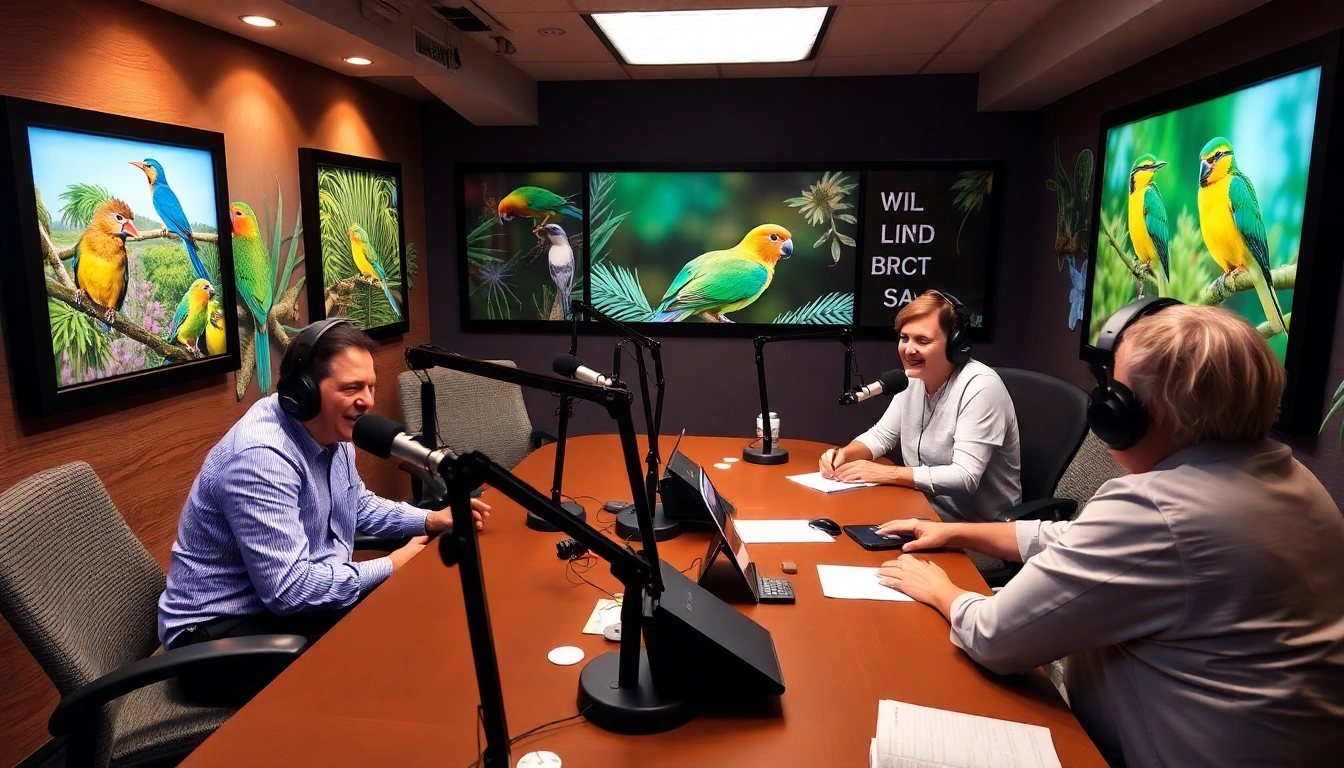Introduction to Bird Talk Radio and Its Mission
In the vibrant world of avian enthusiasts and bird lovers, Bird Talk Radio stands out as a premier platform dedicated to celebrating, educating, and connecting people with the diverse and fascinating realm of wild birds and avian conservation. Since its inception, Bird Talk Radio has committed to fostering a deeper understanding of bird species, behaviors, habitats, and the critical issues facing bird populations worldwide. This comprehensive guide explores the evolution of the show, its core mission, and its vital role in the birding community, providing insights for enthusiasts, professionals, and casual listeners alike.
History and Evolution of the Show
Bird Talk Radio’s journey began over a decade ago with a simple yet ambitious goal: to create an accessible, engaging platform where bird aficionados and conservationists could exchange knowledge and experiences. Originally launched as a local supplement to regional birding groups, the show quickly gained popularity due to its authentic content, interactive format, and talented hosts. Over time, technological advancements, including streaming services and social media, allowed Bird Talk Radio to expand its reach nationally and even internationally.
Throughout its evolution, the program has embraced changes in media consumption habits, transitioning from traditional terrestrial radio broadcasts to a robust online presence. Its website, Bird Talk Radio, now hosts live streams, podcasts, and an active community forum, enabling listeners to engage anytime and anywhere. This adaptability has cemented the show’s reputation as a leading authority in avian communication and education, continuously adapting new formats such as video content, virtual events, and interactive webinars.
Core Topics and Focus Areas
At the heart of Bird Talk Radio lies a commitment to covering a broad spectrum of topics that resonate with their diverse audience. These include:
- Wild Bird Identification and Behavior: Identifying different species, understanding their habits, migration patterns, and unique behaviors.
- Bird Conservation and Environmental Issues: Raising awareness of habitat loss, climate change impacts, and conservation strategies.
- Bird Feeding and Habitat Creation: Practical advice on attracting and supporting local bird populations through bird-friendly gardening and feeder setups.
- Expert Interviews and Guest Speakers: Discussions with wildlife biologists, conservationists, bird keepers, and industry leaders sharing insights and latest research findings.
- Community and Citizen Science: Promoting participation in bird counts, habitat restoration projects, and other citizen science initiatives.
By focusing on these key areas, Bird Talk Radio provides a comprehensive resource hierarchy that educates and inspires action among its audience, ensuring the preservation and appreciation of avian diversity.
Audience and Community Engagement
Understanding Bird Enthusiasts
The audience of Bird Talk Radio encompasses a wide demographic—ranging from casual birdwatchers and backyard feeders to professional ornithologists and wildlife rescue operators. What unites them is a shared passion for birds and a desire to learn more about their feathered friends and the challenges they face.
Interactive Platforms and Digital Community
Beyond traditional radio, Bird Talk Radio leverages multiple channels to foster community engagement. Its website offers live streaming, downloadable episodes, blogs, and forums for discussions. Social media platforms further facilitate real-time interaction, guest Q&As, and community-building activities. Listeners contribute by sharing sightings, photos, and stories, creating a vibrant, participatory ecosystem.
This multi-platform approach ensures that the show isn’t just a passive listening experience but a dynamic, two-way dialogue fostering trust, loyalty, and collective learning.
Connecting Bird Enthusiasts Through Platforms and Expert Content
Popular Streaming and Broadcast Channels
Bird Talk Radio maintains a strong presence across various digital mediums. Its core transmission occurs via terrestrial radio still at select stations like Denver’s 710 KNUS and 990 AM, offering traditional audience engagement. Simultaneously, online streaming through its website and podcast platforms on Spotify, Apple Podcasts, and other services allow global access, extending its listenership beyond geographical limits.
On platforms such as Bird Talk Radio, the content is complemented by archived episodes, live chat interactions, and on-demand listening, catering to modern media consumption preferences.
Expert Interviews and Educational Content
A hallmark of Bird Talk Radio is its inclusion of guest speakers—from wildlife biologists to avian rescue organizations. Each interview is crafted to be both informative and engaging, often covering themes such as migration science, bird rehab tips, and conservation policies. These expert insights are designed not merely for entertainment but to equip listeners with actionable knowledge to help birds in their local environments.
Listener Contributions and Call-In Segments
One of the show’s most beloved features is its interactive call-in segments. Listeners from around the country call in to share sightings, seek advice, or discuss bird-related issues. This approach builds a strong sense of community, enabling shared learning, support, and collective problem-solving.
Developing Content Strategies to Grow and Diversify Bird Talk Radio
Educational and Entertaining Content Creation
Effective content combines rigorous scientific facts with compelling storytelling. Bird Talk Radio achieves this by translating complex ornithological research into accessible language, often accompanied by vivid anecdotes and real-world examples. Incorporating stories of conservation successes, individual bird rescues, and migration mysteries keeps the content captivating and memorable.
Additionally, thematic series—such as migratory bird journeys or nesting behaviors—are used to deepen engagement, encouraging audiences to follow episodes and participate in related activities like bird counts or habitat projects.
Utilizing Audio and Visual Media
While audio remains central, visual media significantly enhances educational value. Short videos, infographics, and photo galleries shared through social media increase understanding of bird identification, feeding techniques, and habitat restoration. Live video feeds during bird banding sessions or nest monitoring offer immersive experiences that boost viewer interest and loyalty.
Podcasts, YouTube segments, and webinars are also employed to reach niche segments, such as exotic bird enthusiasts or budding ornithologists, thereby broadening the show’s appeal and educational scope.
Building a Loyal Follower Base
Consistency, authenticity, and community interaction are key in cultivating a dedicated following. Regular publishing schedules, transparent communication, and engaging content foster trust. Incentives like birding challenges, photo contests, and opportunities for listener participation further embed the audience into the show’s ecosystem.
SEO and Digital Marketing Strategies for Bird Talk Radio’s Growth
Optimizing Website Content for Search Engines
Effective SEO is crucial for attracting new listeners. Bird Talk Radio’s website integrates targeted keywords such as “bird talk radio,” “wild birds,” and “bird conservation” throughout its content. Meta descriptions, header tags, and image alt texts are optimized to enhance search engine visibility.
Creating comprehensive, in-depth blog articles and resource pages on bird species, conservation tips, or DIY birdfeeding guides helps generate organic traffic. Incorporating structured data and schema markup can improve search engine understanding and rich snippets.
Leveraging Social Media and Podcast Platforms
Social media promotions on Facebook, Twitter, Instagram, and LinkedIn help increase reach and engagement. Collaborations with birding influencers, conservation organizations, and community groups amplify visibility. Sharing bite-sized content, teaser clips, and behind-the-scenes footage encourages followers to tune in regularly.
Podcast directories like Apple Podcasts, Spotify, and Google Podcasts are optimized with compelling descriptions, keywords, and high-quality cover art to improve discoverability. Cross-promotion within episodes and through social media ensures consistent audience growth.
Analyzing Audience Data for Strategy Refinement
Using analytics tools to monitor website traffic, listenership patterns, and engagement metrics enables data-driven decision-making. Identifying popular topics, peak listening times, and demographic preferences guides content planning and marketing efforts. Regular feedback surveys and community polls also inform improvements and new topic development.
Future Trends and Opportunities in Bird Talk Radio
Integrating Interactive Technologies
Upcoming innovations include integrating real-time bird identification apps, augmented reality (AR) experiences, and virtual reality (VR) field trips. These tools can make bird watching and education more immersive and interactive, appealing to younger audiences and tech-savvy listeners.
Expanding Content Through Collaborations
Partnerships with environmental NGOs, educational institutions, and other media outlets will broaden content diversity. Co-produced series, joint webinars, and conservation campaigns foster a multidisciplinary approach, expanding the show’s influence and resource base.
Adapting to Changing Media Consumption Habits
With the rise of short-form content, platforms like TikTok and Instagram Reels offer opportunities to share quick tips, bird calls, or stunning visuals to attract new followers. Additionally, personalized listening experiences through AI-driven recommendations can boost retention. Embracing these trends ensures Bird Talk Radio remains relevant and impactful in an evolving digital landscape.






